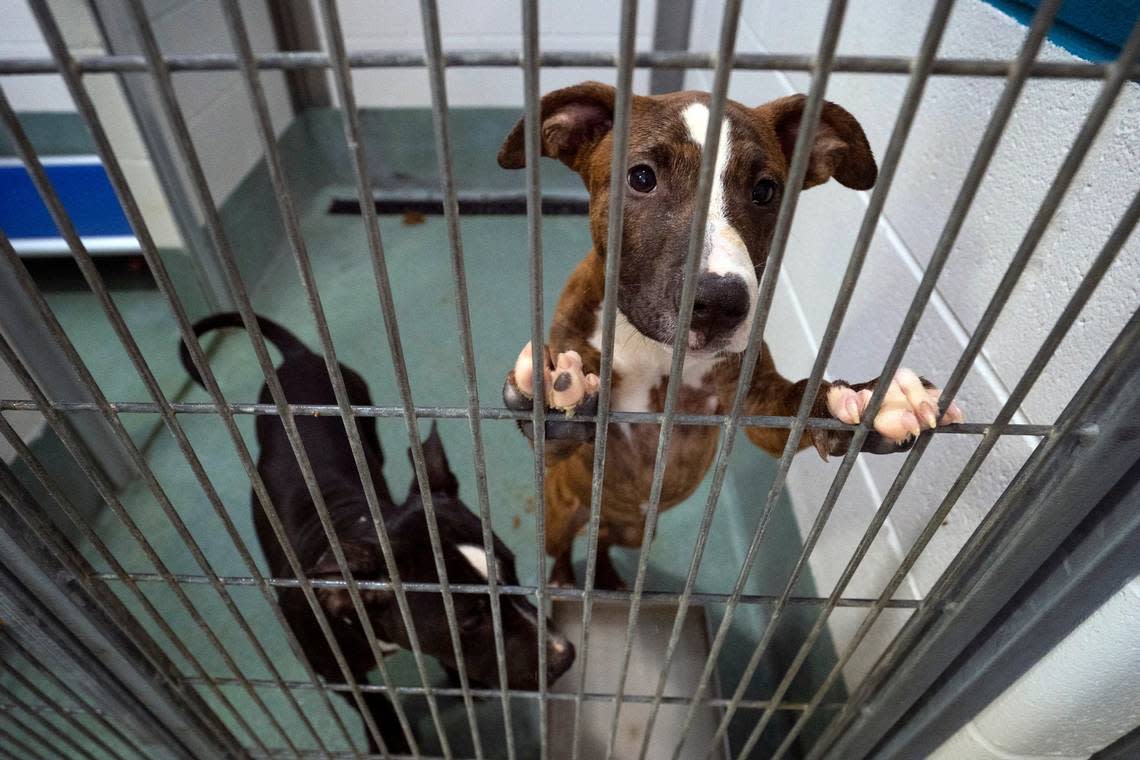These animal shelters and rescues want to end space-based euthanasia by 2025
More than 1,400 animal shelter and rescue workers gathered in Raleigh this week to discuss how to stop killing animals when shelters run out of room.
Best Friends, the Utah rescue group that has become a national name in shelter improvement, aims to get all shelters to euthanasia rates of 10% or less by 2025. The goal is to kill only those animals that are at the end of their life, need greater medical care than the shelter can provide, or are truly dangerous.
Mark Peralta, chief program officer for Best Friends, says the conference, held at the Raleigh Convention Center, helps shelters share strategies they’ve used to reduce kill rates.
“Most of the animals in our shelters that fall into what most shelters call euthanasia are actually animals that maybe have separation anxiety but are really great with people,” Peralta told The News & Observer. “Or [they] have nothing wrong with them at all; they [the shelters] just run out of space and time.”
Euthanasia in North Carolina
Euthanasia has been seen as a viable animal population control measure since the 19th century, said convention speaker Kristen Hassen, who is the director of American Pets Alive!
Animal welfare policies dating back to then have focused on identifying the most effective mass euthanasia strategies, including drowning and gassing dogs. This continues to cause high kill rates for some animals in shelters, including large dogs.
Hassen said that even when she started working in shelters in 1999, “there wasn’t an understanding built into the law that animals should get out alive.”
Last year 10,291 dogs and 25,332 cats were euthanized in North Carolina, the N.C. Department of Agriculture and Consumer Services reported. That’s over 21.6% of all animals that entered shelters, the third highest euthanasia rate in the country.
Nationally, 17% of pets who entered shelters in 2021 were euthanized on average, Best Friends reported.
Best Friends chose Raleigh for this year’s convention to reach more North Carolina shelters, providing scholarships and travel stipends to some attendees.
Texas, Alabama, Florida and California join North Carolina in having the highest rates of “kill shelters”, or animal shelters with euthanasia rates over 10%.
Peralta attributes this gap to population growth, as well as to cats, which make up the majority of animals currently dying in shelters.
“It’s a prominent thing not just in North Carolina, but especially in North Carolina,” Peralta said. “So we wanted to bring people to the states that need the most help and attention.”

Life-saving strategies
The conference,which began Thursday and runs through Saturday, features over 200 speakers, including Jennifer Federico, the Animal Welfare Services director for Wake County.
Interventions to get dogs out of shelters can occur at several points between arrival and euthanasia. Speakers discussed moving dogs straight into foster homes to reduce intake volumes, coordinating low-cost spay-neuter programs and posting new dogs on social media to encourage fast adoptions.
Others focused on reducing medical and behavioral euthanasia, with new medical treatments and with calls to stop labeling dogs that haven’t hurt people or other animals “aggressive.”
Some shelters which have successfully stopped euthanizing for space, came to coach attendees hoping to do the same while still keeping animals’ stays under a few weeks.
CARE St. Louis, which assumed ownership of the St. Louis municipal shelter after it was shut down in 2011 for using gas to euthanize dogs, described the legal process of taking over a kill shelter. The Humane Society of Midland County, Mich. explained how new intake procedures have supported a drop in euthanasia rates from 30% to 2% over the last decade, while still getting most dogs out of the shelter in under three months.
“We’re hitting a time like I’ve never seen,” said Marianne Sung, whose Nashville rescue wants to start taking in dogs over 35 pounds and who came to Raleigh seeking advice.
“[Employee] turnover is high, everybody’s having staffing shortages, so I think that people are just trying to do the best that they can,” Sung said.
Involving the community
Shafonda Allen, executive director of the Animal Protection Society of Durham, attended sessions on building shelter leadership and getting community members more involved.
The APS has already implemented initiatives like adoption specials and pet food pantries, and has reduced its annual intake from 7,000 to 4,000 animals. In 2021, Durham’s euthanasia rate was 30.1%, excluding dogs brought in by their owners for voluntary euthanasia.
Allen has noticed intake rising again, though, which she attributes to financial strain and landlord pet restrictions across Durham County. She hopes to bring back more strategies from the conference.
“It’s changing every single day,” Allen said of animal welfare. “And the best way to learn is from each other, and the best way for us to do that is to get together.”
